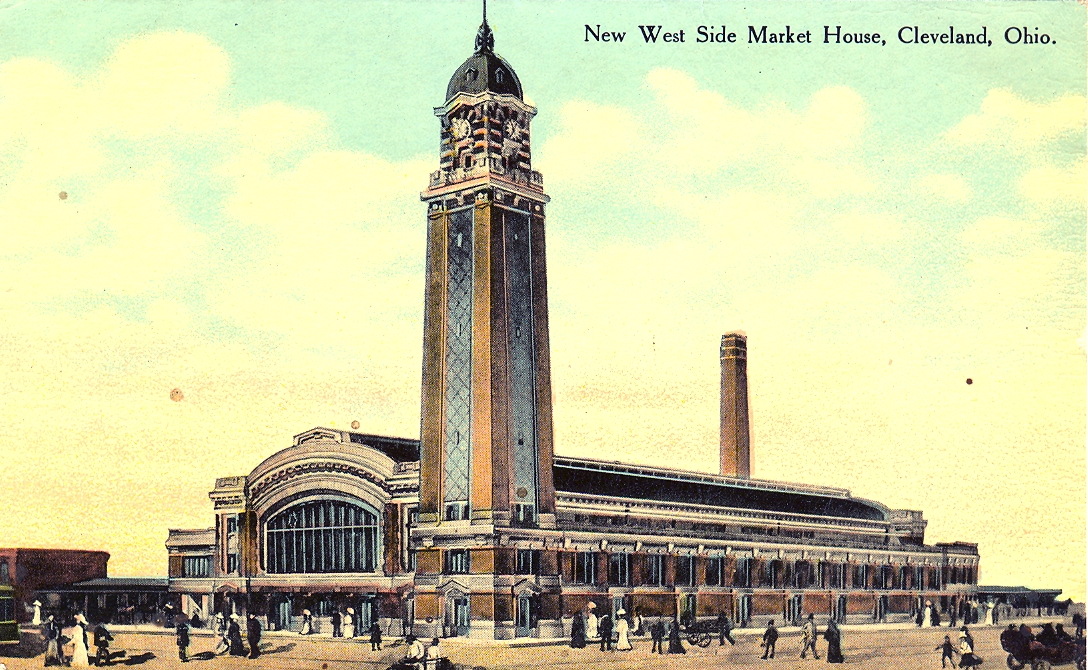- West Side Market
Infobox_nrhp | name =West Side Market
nrhp_type =

caption = The West Side Market, circa 1912
location=Cleveland, Ohio
lat_degrees = 41
lat_minutes = 29
lat_seconds = 4
lat_direction = N
long_degrees = 81
long_minutes = 42
long_seconds = 11
long_direction = W
locmapin = Ohio
area =
built =1912
architect= Hubbell & Benes
architecture= No Style Listed
added =December 18 ,1973
governing_body = Local
refnum=73001423cite web|url=http://www.nr.nps.gov/|title=National Register Information System|date=2007-01-23|work=National Register of Historic Places|publisher=National Park Service]The West Side Market is
Cleveland, Ohio 's oldest operating indoor/outdoor market space. It is located at the corner of West 25th Street and Lorain Avenue in the Ohio City district. OnDecember 18 ,1973 , it was added to theNational Register of Historic Places .History
The market began operating in 1840, across the street from the market’s current location.
Josiah Barber andRichard Lord , prominent businessmen and both former mayors of Ohio City prior to its incorporation into Cleveland, donated the tract of land to Ohio City's government, with stipulation that the land be used to create a sustaining open-air neighborhood market. The market space acted as an Ohio City community center for the following three decades, and other benefactors donated adjacent lands to allow the marketplace to expand. In 1868, a one story, wooden framed building was erected on the site, and the newly christenedPearl Street Market was opened.However, the brisk population growth in Cleveland and Ohio City in the latter part of the 19th century led to the market outgrowing its space yet again. In 1902, lands were purchased across the street from the Pearl Market site, to allow for market expansion and eventual construction of additional indoor market space. A Cleveland architectural firm,
Hubbell and Benes , was contracted to create the new indoor space and, after nearly a decade of planning and construction, the current West Side Market building was finished in 1912 at a cost of nearly $680,000. The architecture of the building consists of a brick construct with a large interior concourse, which provides nearly 100 stalls for sellers, and an outdoor produce arcade, containing 85 stalls and wrapping around the side and rear of the main building. In addition, the building has a largeclock tower , which was easily visible from most of the Ohio City area in the building's early days. The architecture of the building is commonly referred to as a Neo-Classical/Byzantine style.With the establishment of the permanent market site, sellers at the market decided to establish a coalition to help maintain the market, as well as organize for future improvements and additions to the market. In 1915, the West Side Market Tenants' Association was founded; this organization still exists at the Market today. As the market continued operation in the 20th century, periodic upgrades were made to accommodate tenants, as well as other projects undertaken to maintain and improve the overall conditions at the market. The market was modernized in 1953, including new lower-level storage areas and modernized stalls in the arcade space, at a cost of $1.1 million, and was also heavily renovated at a cost of $5 million in the 1970s. These latter renovations occurred after the Market was added to the National Register of Historic Places in 1973.
The profile of the market was raised in the latter portion of the 20th century. Politicians passing through Cleveland often made a point of stopping at the market, often to sample the array of foods that the Market has on sale on any given day. The Market also began sponsoring major food festivals in the neighborhood, which drew persons from all corners of Cleveland and abroad to the Market, further increasing its appeal and renown. Despite the successes of the 1980s, however, the Market began to face financial straits as Cleveland itself was experiencing monetary struggles. A large portion of the Market’s subsidies from the city dried up, leaving tenants of the Market to pay higher rents to keep the Market open. Despite this minor setback, the Market continued to churn onward, further expanding and renovating throughout the 1990s and into the 21st century. The most recent renovations at the market completed in the winter of 2004, including enclosure of the arcade portion of the market, space heating within that space, and major interior and architectural renovations to the main building.
Culture and tourism
The market attracts a large crowd of both loyal locals and curious tourists. Many persons come from all parts of the United States to tour the market and learn about its history – the tourism has become large enough for the market to offer its own guided tours for interested out-of-towners. Many tourists are also drawn to the Market due to television exposure it has received in recent years through profiles on various programs produced by the
Travel Channel andFood Network . Most residents of the neighborhood, and many Clevelanders in general, still do a large portion of their shopping at the Market today, despite asupermarket boom in the area.Through the market's history, the tenants and sellers have come from a broad base of backgrounds, representing the cultural diversity of the surrounding neighborhood and Cleveland as a whole. The current roster of tenants includes those of Irish, German, Slovenian, Italian, Greek, Polish, Russian, and
Middle East ern descents, among others. In addition, many stalls at the Market have remained under individual family control for much of the life of the Market, in a few cases dating back to the original opening in 1912.References
External links
* [http://www.westsidemarket.com West Side Market's Official Website]
* [http://ech.cwru.edu/ech-cgi/article.pl?id=WSM The Encyclopedia of Cleveland History: West Side Market]
* [http://www.city.cleveland.oh.us/government/departments/parksrecprop/prpcwsm/prpwsm/prpwsmind.html City of Cleveland: West Side Market Profile]
* [http://www.crainscleveland.com/apps/pbcs.dll/article?AID=/20050620/LANDMARK/50420004 Crain's Cleveland Business: Cleveland Landmarks Page]
Wikimedia Foundation. 2010.
